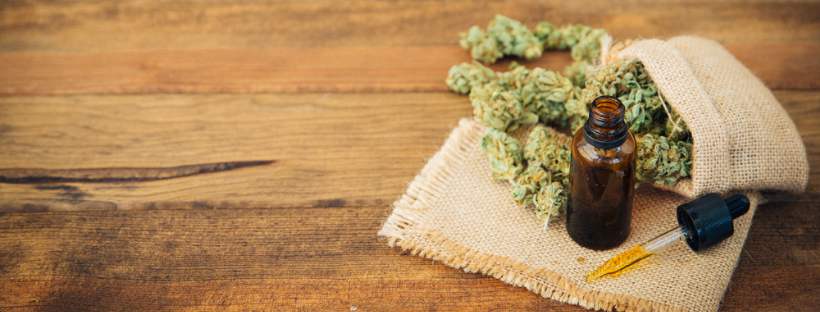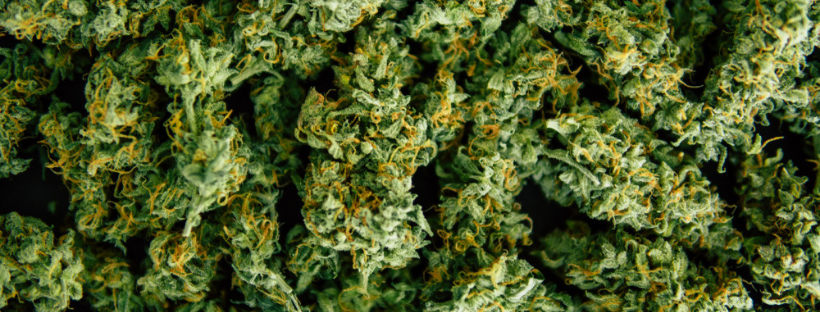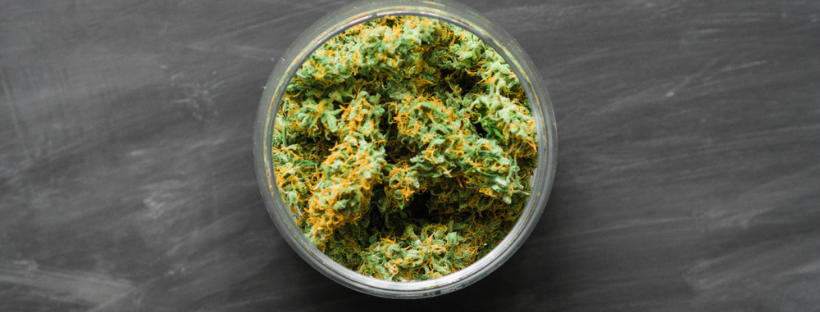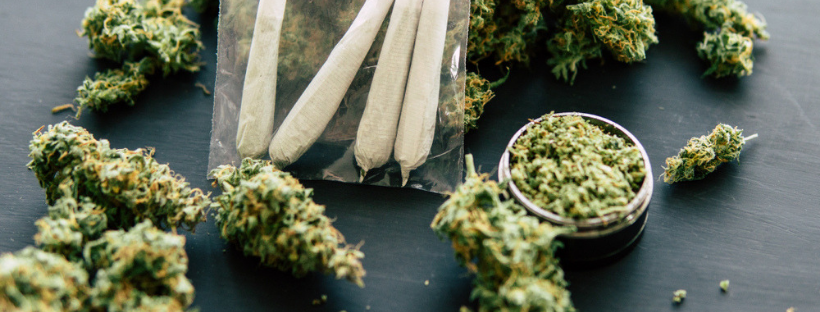The cannabis plant consists of over 400 chemical compounds, about 140 of which belong to a broad class of natural, fragrant hydrocarbons called terpenes.
The terms “terpenes” and “terpenoids” are often used interchangeably; however, they have a slightly different meaning.
The most striking difference between the two lies in their chemical makeup. Simply put, terpenes are comprised solely of carbon and hydrogen, whereas terpenoids are formed during the drying and curing process of cannabis flowers when they undergo oxidation.
Today, however, we’re going to focus exclusively on terpenes.
We will map out the following details:
- Where to find terpenes
- The role of terpenes in marijuana
- Why terpenes work synergistically with THC, CBD, and other cannabinoids
- Are terpenes safe?
- What’s the difference between terpenes and flavonoids?
- The top 8 terpenes to look for in cannabis
Let’s get down to it!
Fantastic Terpenes And Where to Find Them
Do you have any weed at hand?
Then grab one bulky nug and closely examine its surface.
What do you see?
Is it a beautiful coating of crystal-like resin?
These are trichomes where both cannabinoids and terpenes are synthesized.
The highest concentration of terpenes can be found in unfertilized female marijuana flowers before they start to get old; as the weed ages, the amount of terpenes gets significantly reduced.
Terpenes are released either through vaporization or steam distillation. For most terpenes, the vaporization process takes place at 80 C, but some of them are less volatile and need higher temperatures, around 157 C — the same temperature activates THC.

What Role Do Terpenes Play In Marijuana?
The vast majority of people link terpenes only to the fragrance they produce for different plants.
To some extent, they are right. But on the other hand, there’s more to terpenes than meets the eye — or nose, in this case.
First of all, they create a natural protection system for the cannabis plant, shielding it against insects, fungus, bacteria, and other environmental dangers. This is why terpenes are invaluable in cannabis cultivation.
Moreover, terpenes come with a range of therapeutic properties on top of their sensory value. Back in the days, when cannabis was stigmatized by the public opinion, researchers believed that the only chemical compound capable of affecting the mind, emotions, and behavior was THC.
But as the legalization is moving forward across the world, scientists are now researching other cannabinoids along with terpenes and flavonoids. At the time of writing, we already know that cannabinoids and terpenes produce synergistic effects and boost the therapeutic value of marijuana.
How is that possible?
To answer this question, we must elaborate on the entourage effect phenomenon in the cannabis plant.
The Entourage Effect: Embracing the Synergy Between Terpenes and Cannabinoids
If you’re new to cannabis, then the entourage effect may sound unfamiliar. However, scientists are well acquainted with this phenomenon and they have been studying it for quite some time.
The entourage effect describes a unique relationship between cannabinoids, terpenes, and flavonoids.
When the above compounds are present together in cannabis extracts (or dried buds), they boost the therapeutic properties of one another while mitigating the psychoactive effects of THC. It’s worth to note that these substances are not capable of such things when used on their own.
In other words, whole buds and whole-plant extracts are believed to work better for medical users than isolate-based products.

Studies On the Entourage Effect
The entourage effect is well backed by scientific evidence. There are three major studies that reveal the “Why” behind the aforementioned synergy.
The first study, published by E. A. Carlini and I. G. Karinol, have concluded that marijuana strains with equal or higher levels of CBD to THC can bolster the therapeutic effects of marijuana up to 4 times as much as THC alone.
On top of that, the study has concluded that smoking twice as much of a THC isolate has no impact on the overall experience save for the fact that the high can be described as dull and that THC on its own can trigger anxiety and paranoia when consumed at high doses.
Another comparative study showed that regardless of the examined case, THC might not be necessary (at high doses) to achieve the desired effects. The study clearly demonstrated that the therapeutic qualities of marijuana are not limited to its THC levels.
Finally, a study by cannabinoid expert Dr. Ethan Russo supports the hypothesis that non-cannabinoid marijuana compounds such as terpenes and flavonoids can alleviate the psychological toxicity of excessive doses of THC.
Russo refers to this phenomenon as the “phytocannabinoid-terpenoid synergy” meaning that the constituents of marijuana increase the plant’s ability to treat anxiety, depression, pain, inflammation, infections, substance dependence, and even cancer.
Are Terpenes Safe?
Yes, they are!
These organic oily substances that contribute to fragrances and flavors in different products have been acknowledged by the FDA (along with other agencies) as safe.
As discussed, terpenes have a wide range of effects on the brain. For instance, they boost norepinephrine activity and increase both serotonin and dopamine levels. Interestingly, they appear to work similarly to prescription antidepressants.
However, more research is needed in order to make further claims about the antidepressant potential of terpenes, as well as how they can be used to help medical marijuana patients target certain illnesses more accurately.
Terpenes & Flavonoids
Flavonoids are the largest nutrient groups known to scientists. There are over 6,000 already-discovered flavonoids, and about 20 of these naturally occurring chemicals are found in the marijuana plant.
Flavonoids have antioxidant and anti-inflammatory properties and they are also responsible for the color of the foods we eat; this is why raspberries are ruby-red and blackberries are ink-black.
As for their pharmacological effects, those sourced from the cannabis plant has shown promising effects in preclinical studies. However, those findings need further research to gain us new insight into the importance of flavonoids and the way they affect the marijuana treatment.

The Terpene Wheel
Terpenes are constituents of complex plant pigments, molecules, sterols, hormones, and cannabinoids.
On the one hand, they are responsible for the alluring aroma of marijuana, but on the other, they produce a range of physiological and psychological effects, which makes scientists curious of whether or not these two features share a common denominator.
Medical marijuana patients often ask their budtender at a dispensary if they can smell cannabis buds when picking up their strains; they say it helps them predict the effects of their go-to flower.
The concentration on specific terpenes in the marijuana plants depends on how and when they were harvested. Although cannabis contains over 140 terpenes, only some of them appear in concentrations significant enough to make us able to spot them by their aroma.
Cannabis breeders, along with cannabinoid researchers, have created the terpene wheel that helps people identify the terpenes in each strain.
For example, strains that smell of pine (high concentration of terpene pinene) promote alertness and prevent short-term memory impairments; lemony and citrus aroma (limonene) can help with mood swings and boost the overall energy levels; the smell of musk or clove (myrcene) is responsible for sedative effects.
This infographic illustrates the difference between strains based on the aromas brought by specific terpenes.
8 Most Important Terpenes In Cannabis
Here are 8 terpene profiles you should make yourself familiar with if you want to get the most out of your marijuana experience.
1. Limonene
- Aroma: Citrus
- Effects: Limonene can stimulate metabolism, prevent and treat cancer, and fight bronchitis. This terpene is also used to make medicinal marijuana-infused topicals. Consuming strains with high levels of limonene can uplift your mood, bring euphoria, and sharpen focus.
- Popular strains: Green Crack, Super Lemon Haze, Orange Bud, Hindu Kush, Emerald Jack, Cookies and Cream
2. Pinene
- Aroma: Pine. This terpene gives pine trees its unique scent.
- Effects: Pinene has been found to act as an anti-inflammatory and memory booster. The second feature makes pinene-rich strains a great option for daytime use when you know you can’t hide from your duties.
- Popular strains: Jack Herer, Dutch Treat, Romulan, Blue Dream, Island Sweet Skunk, OG Kush
3. Myrcene
- Aroma: earthy and musk scent accompanied by notes of cloves.
- Effects: Myrcene is what makes certain marijuana strains feel heavy or couch-locking. It also has anti-inflammatory properties. Myrcene is most commonly found in the indica varieties of cannabis.
- Popular strains: Purple Kush, Himalayan Gold, White Widow, Warlock CBD, Mango Haze, Skunk XL, Special Kush #1
4. Linalool
- Aroma: Floral. You can find Linalool in many flowers and spices, such as lavender or coriander.
- Effects: Linalool comes with a plethora of beneficial effects. Since ancient times, people have been using this terpene to fight anxiety and depression, lower stress levels, reduce inflammation, and combat sleep disorders.
- Popular strains: Amnesia Haze, Lavender, LA Confidential, Purple Kush, OG Shark, Master Kush, Pink Kush
5. Bisabolol
- Aroma: Bisabolol is a fragrant terpene produced by plants that come with calming properties, such as chamomile, or a less popular plant, Candeia tree in Brazil.
- Effects: This terpene is widely used among the beauty companies to produce various cosmetics. Now, Bisabolol is being researched for its therapeutic benefits in cannabis. The current data on Bisabolol’s medical applications suggest that the compound can work as an anti-irritant, anti-microbial, anti-inflammatory, and painkiller.
- Popular strains: Girl Scout Cookies, Sour Diesel, Black Lime, Gold Country Afgoo, ACDC, Headband, Harle-Tsu
6. Caryophyllene
- Aroma: Hoppy. Actually, hops and cannabis are close cousins.
- Effects: Caryophyllene can be used to treat anxiety and depression. In addition, recent studies suggest that this terpene also comes with anti-inflammatory and neuroprotective properties.
- Popular strains: Death Star, Candyland, Lemon G, Blueberry Cheesecake, Sour Bubble, Bubba Kush, Skywalker OG, Trainwreck
7. Trans-nerolidol
- Aroma: Trans-nerolidol comes with a floral aroma underlined by hints of apple, rose, and citrus. He terpene appears in many strong aromatics, such as jasmine, lemongrass, and tea tree.
- Effects: This terpene is known to have antifungal, antiparasitic, and antimicrobial properties. In addition, Trans-nerolidol can induce sedation which can often transform into the so-called couchlock.
- Popular strains: Island Sweet Skunk, Skywalker OG, Jack Herer
8. Terpineol
- Aroma: Terpineol smells much like pine trees, lime blossoms, and lilacs. This terpene is used to infuse lotions, perfumes, and soap; it occurs in strains that have a high level of pinene.
- Effects: Terpineol-rich marijuana strains can bring up relaxation, ease the pain, and reduce the damage caused by oxidative stress. Terpineol shows great potential as a potential support treatment for autoimmune disorders.
- Popular strains: White Widow, Girl Scout Cookies, OG Kush, Jack Herer

How to Find a Perfect Terpene Match
At this point, you’re probably wondering how to use the above knowledge to draw upon the benefits of terpenes through cannabis.
Since we have evolved to develop the endocannabinoid system, it means our bodies are hardwired to using cannabis.
That being said, cannabis plants have created their own pattern of telling us how to choose the ideal strain for our unique body chemistry — it happens through terpenes.
As mentioned, terpenes allow us to “sample” certain weed strains without having to smoke them. Almost every marijuana user has his or her favorite strain, not only because of the effects but also because of the unique aroma it teases your nostrils with.
Finding a perfect terpene match is actually pretty straightforward.
When browsing through different strains or concentrates, simply smell the product before buying. If you find the aroma profile appealing, it’s a good indicator that you should buy some of its buds.
If, on the other hand, you dislike the odor, the strain might not be the best fit for you.
Planning to order your buds online? Always make sure to read the strain description, specifically its effects and fragrance, as it will help you predict what to expect from the particular variety.
Final Thoughts On Terpenes in Cannabis
Terpenes have already drawn the attention of psychopharmacologists and researchers interested in the therapeutic benefits of the cannabis plant.
As it turns out, terpenes are about way more than just the bag appeal of your weed. In fact, they can make or break your experience with marijuana because of their unique properties and various interactions with THC, CBD, and other cannabinoids.
There is still much to learn about the possible medical applications of terpenes, but the current data fills us with a hope that sooner or later (preferably sooner), the world of these fragrant molecules will open its gates and help us understand why whole buds and full-spectrum extracts are more effective than isolate-based products.
What are your favorite terpenes? Are you more into citrusy and exotic aromas, or do you prefer milder scents such as lavender or chamomile? Did you know that terpenes can change the way we benefit from cannabis?
We can’t wait to hear you out!


One thought on “A Guide to Terpenes”